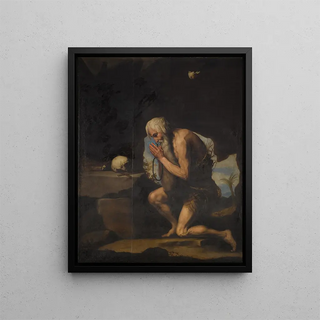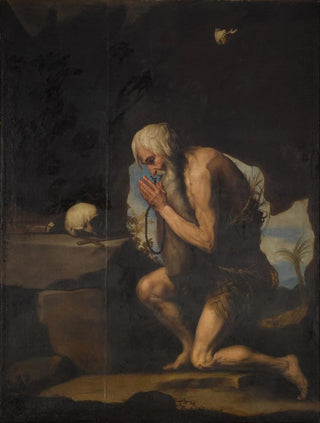Art print | Saint Paul the Hermit - School of Jusepe de Ribera


View from behind

Frame (optional)
Saint Paul l'Ermite art print - Jusepe de Ribera School – Captivating Introduction
In the fascinating world of baroque art, few works manage to capture the human soul with such intensity as "Saint Paul l'Ermite" by Jusepe de Ribera. This iconic piece immerses us in a universe where light and shadow intertwine to reveal the depth of spirituality. The painting, with its striking realism, invites the viewer to silent contemplation, allowing exploration of themes of solitude and faith. The Saint Paul l'Ermite art print - Jusepe de Ribera School offers a unique opportunity to rediscover this masterwork, while making it accessible to a broader audience.
Style and uniqueness of the work
The strength of this piece lies in the masterful treatment of light, an emblematic feature of Ribera's style. The artist plays with contrasts to emphasize the features of Saint Paul’s face, marked by age and experience. The meticulous details, from wrinkles to calloused hands, testify to a life of renunciations and meditations. The dark, almost austere background highlights the figure of the saint, creating an atmosphere of reverence. The color palette, dominated by earthy tones, enhances the realistic and almost tactile nature of the scene. Ribera, as a master of light, manages to breathe palpable life into his subject, transforming a simple depiction into a true spiritual experience.
The artist and his influence
Jusepe de Ribera, born in Spain and having spent much of his life in Naples, is considered one of the greatest artists of the 17th century. His work is rooted in the baroque movement, characterized by an relentless pursuit of emotion and movement. Ribera, often called "the Spagnolo" in Italy, skillfully combined influences from Caravaggio and Spanish masters to create a unique style. His realistic approach and ability to capture human essence profoundly influenced his contemporaries and subsequent generations. Through iconic figures like Saint Paul, Ribera explores universal themes such as suffering, redemption, and the search for meaning, concerns that resonate

Matte finish

View from behind

Frame (optional)
Saint Paul l'Ermite art print - Jusepe de Ribera School – Captivating Introduction
In the fascinating world of baroque art, few works manage to capture the human soul with such intensity as "Saint Paul l'Ermite" by Jusepe de Ribera. This iconic piece immerses us in a universe where light and shadow intertwine to reveal the depth of spirituality. The painting, with its striking realism, invites the viewer to silent contemplation, allowing exploration of themes of solitude and faith. The Saint Paul l'Ermite art print - Jusepe de Ribera School offers a unique opportunity to rediscover this masterwork, while making it accessible to a broader audience.
Style and uniqueness of the work
The strength of this piece lies in the masterful treatment of light, an emblematic feature of Ribera's style. The artist plays with contrasts to emphasize the features of Saint Paul’s face, marked by age and experience. The meticulous details, from wrinkles to calloused hands, testify to a life of renunciations and meditations. The dark, almost austere background highlights the figure of the saint, creating an atmosphere of reverence. The color palette, dominated by earthy tones, enhances the realistic and almost tactile nature of the scene. Ribera, as a master of light, manages to breathe palpable life into his subject, transforming a simple depiction into a true spiritual experience.
The artist and his influence
Jusepe de Ribera, born in Spain and having spent much of his life in Naples, is considered one of the greatest artists of the 17th century. His work is rooted in the baroque movement, characterized by an relentless pursuit of emotion and movement. Ribera, often called "the Spagnolo" in Italy, skillfully combined influences from Caravaggio and Spanish masters to create a unique style. His realistic approach and ability to capture human essence profoundly influenced his contemporaries and subsequent generations. Through iconic figures like Saint Paul, Ribera explores universal themes such as suffering, redemption, and the search for meaning, concerns that resonate






